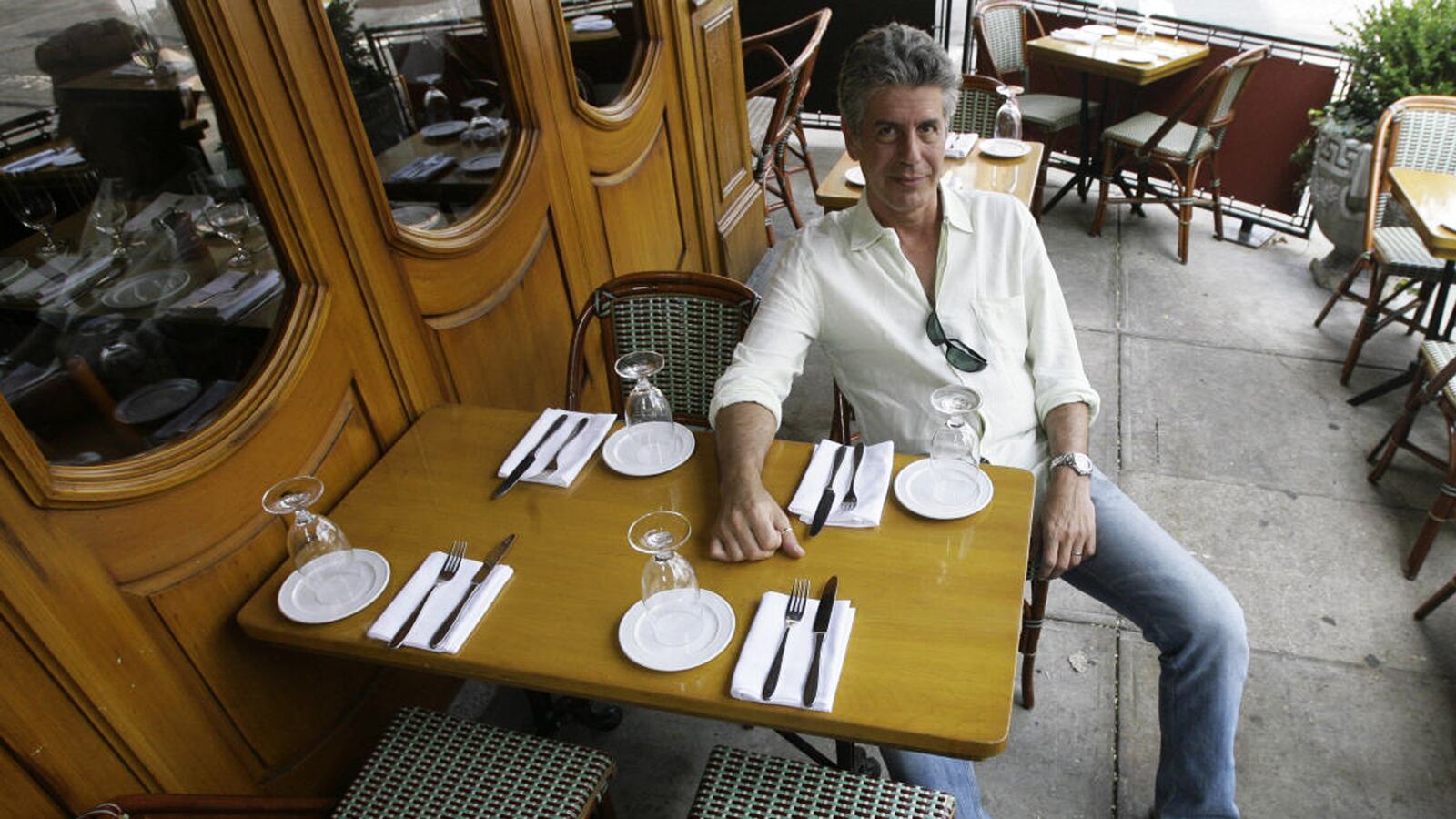It’s strangely poignant that Anthony Bourdain should end his life in France, because nobody did more than he did to end the long hegemony of France over international cuisine.
Few of those who followed him on CNN as he relished exotic entrails, smelly noodles, the most inflammatory spices, will have realized that not so long ago all these pleasures were virtually shut out of any chance of recognition as serious food by the belief that only France could decide what counted as world-class dining.
Now, as we slowly realize the seriousness of the loss of Bourdain to the unalloyed joys of eating, his democratizing impact on global cuisine becomes more and more apparent. It virtually equals the destruction of a religion.
France was the holy ground of that religion. The French dictated the terms on which eating could be enjoyed as though they represented an absolute gastronomic deity. There was even the sacred book of catechisms, between red covers and ordained in dense and didactic texts—the Michelin guidebooks.
Throughout France, the threat of visiting anonymous Michelin inspectors tyrannized every chef. Michelin’s judgment of a chef’s performance, delivered via its signature star-rating system, was based on more than a century of accumulated orthodoxy. The gaining of a star could mean the making of a reputation. The loss of one could be devastating—even, horrifically, provoking suicides.
Bourdain’s own suicide occurred in a French village, Kayersberg, that might have been a backwater but for the fact that it had two restaurants awarded Michelin stars and that it was in Alsace, a sausage-friendly foodie mecca in northeastern France. His traveling companion on the trip was Eric Ripert, chef of the Michelin three-star Manhattan restaurant Le Bernadin.
It was almost as though the cult-like French food regime he had done so much to discard had, in some malicious twist, finally administered a vengeful curse on him.
The real force of Bourdain’s voice was that, although he had been a chef, he spoke and lived at the table, not in the kitchen. He was, above all, an eater. And, true to the punning title of his show, Parts Unknown, he would go literally anywhere and eat anything if it expressed the infinite pleasure of discovering something original and elusively local.
In contrast, the whole culture of French food as declared to the world was defiantly insular—or, to use a French term, chauvinistic. No dish beyond the borders of France was really worth a trip, nor any wine.
Oddly enough, this attitude was brought to America like a virus by another great eater who was also a lyrical writer about eating and whose reverence for French food was contagious.
In the 1920s, a young New Yorker named A.J. Liebling went to Paris to study for a year at the Sorbonne. His father had given him just enough money to have a good time as long as it was limited to the student bohemia.
As far as Liebling was concerned, the food was the biggest revelation of his life. He wrote, “the eater’s apprenticeship, though less arduous, must be as earnest as the cook’s.” It helped that at the time the average price of a meal in Paris was a dollar and 35 cents.
For that sum Liebling learned the unadulterated tastes of a virtual encyclopedia of charcuterie, soups, seafood, offal, terrines, tripes, sausages, game birds and cheap cuts of meat. All washed down with a variety of wines not yet priced for consumption by foreigners with pockets as deep as their cellars.
Later Liebling became a writer at the New Yorker, notable for his eye for the telling detail. He brought that talent to food, as an eater, and invented a narrative voice that for the first time took food writing away from the vocabulary of chefs, using himself as though he was a test specimen for a condition called gluttony, indulging fully in a drug better to understand its effects.
All this was absorbed into a book, Between Meals, that all apprentice eaters lapped up as eagerly as though encountering their first taste of foie gras. I know, because I was one of them.
One effect of this was that, along with all Liebling’s followers, I was suckered into accepting the sovereignty of French cuisine.
For several decades my family was swept up in regular pilgrimages to the many shrines of traditional French food; every summer holiday was spent driving from region to region, dutifully following the Michelin recommendations. These rarely included any stars. They were too expensive and too intimidating. We trawled the lower rankings, indicated by Michelin’s version of the Egyptian hieroglyphs, three crossed knives and forks and downward to a single setting—often a lowly bistro, quietly delivering honest cooking in the deepest shadows of the remorseless Michelin hierarchy.
It was a slavish itinerary but not a disappointing one. There were always culinary treasures specific to place. From the almond macaroons of the Basque country in the far south to the unctuous goose livers of Alsace, from the crab of Normandy to the trout from mountain rivers in the northeastern Jura, dishes that were the simple, natural essence of the land were served as they had been for centuries without all the pomposity of the three-star table where the waiters were as stiff as the linen.
As it happened, there was ultimately one moment of epiphany that combined one of the most illustrious names in the vocabulary of French epicurean conceit with the one of the lowliest of peasant dishes.
Chateau Petrus has for long been among the most expensive Bordeaux wines. Part of its mystique is that the vineyard covers only 30 acres where there is an unreproducable freak of geology, a small cap of clay called the boutonniere. The Merlot grape, notoriously fickle and widely abused, reaches a fragile perfection here—as long as weather in the growing season collaborates. (A single bottle of a prized vintage, 1982, can fetch as much as $6,000 today.)
I was assigned by a travel magazine to investigate this phenomenon at the critical moment when the grapes are picked. That year the moment arrived on the first Monday of October. The morning was sultry. There was dew on the grapes. The pickers—more than 100 of them, most from nearby villages—were held back until afternoon to allow the dew to burn off.
We were invited to join the pickers at lunch in a large whitewashed barn where long communal tables were set out. The food was a classic peasant feast, the kind I would drive hundreds of miles to find: cauldrons of steaming vegetable soup; more cauldrons of blanquette de veau, pale meat peeling from the bone in a tangy broth with potatoes; hunks of coarse bread, a choice of cheeses—and red wine. Not Petrus. It came in three liter bottles, unlabeled and poured freely.
The pickers poured some of the wine into the soup, transforming it into what is called chabrol, a divine fusion that provides an instant sense of well-being.
By the time I made the trip to Petrus, though, I was discovering that the idea of French exceptionalism was no longer sustainable.
Its first and most effective booster had been Georges-Auguste Escoffier, really the original celebrity chef, who built his reputation at the Ritz Hotel in Paris at the end of the nineteenth century and went on to be called “the chef of kings” after being told by the German Kaiser, “I am the emperor of Germany, but you are the emperor of chefs.”
Escoffier’s rule in the kitchen was faites simples—keep it simple. That didn’t apply to the volume of his banquets.
A weekend shooting party before the First World War that he catered enjoyed a dinner that included cabbage and potato soup, chickens with bacon and sausage, a leg of mutton with chestnut puree and an immense tureen containing eight partridges “amply truffled” and cased in fat bacon with celery salad.
Later generations of French chefs cut back on the volume but the grand hotel pretensions of a luxury dining room that Escoffier established became the norm for restaurants that aspired to Michelin stars, a feature that has never really disappeared and is loved now by oligarchs as much as it was by the Kaiser. (Escoffier’s system in the kichen of stations to help expedite the cooking and plating of dishes is still used in modern kitchens.)
Pride of cuisine was (and still is) embedded in French culture to a point where it became inseparable from patriotism. No other country takes it that seriously or is as sensitive about its supposed superiority. But that attitude began to seriously erode after the creation of the European Union. The abolition of hard borders and the far freer movement of people has opened up both minds and palates.
Spain is the most salient example of what this change means to food. While it remained a cultural and political anachronism during the fascist regime of General Franco, Spain’s gastronomic bounty remained largely unknown—and relatively untapped. Now, among all European nations, Spain’s food and wine is as versatile and accomplished as any.
Another outlier, long regarded as a gastronomic wasteland, was Great Britain. Somehow French mockery of Britain as a nation whose tastes were confined to beefsteak and warm beer caught on with Americans, too, who, while happy to pay for such British-branded diversions as afternoon tea and fish and chips, were convinced that the French were right.
But one American never believed in that slander. Twenty years ago, Bourdain walked into a plain, bare-bones dining room near London’s Smithfield meat market. He wrote:
“I ate as much as I could off the menu. After my meal I remember tottering unsteadily into the kitchen, getting on my knees and bowing down in front of Fergus [Henderson, the chef]. It really was the restaurant of my dreams. I loved absolutely everything about it: the attitude, the look, the food, the wine.”
Bourdain had discovered what the rest of the culinary world has now recognized: British cooks had finally learned to recover their deep natural food resources. When it appeared, Fergus Henderson’s restaurant, St. John, was accused of being “200 years out of date.” Now, world famous under its rubric of “nose to tail eating” (no piece of the animal goes to waste) it also stands for what Bourdain brought to his mission—great cooking without pretense.
To this day, St. John has paper table cloths and, whatever the quality of the wine, it is poured into a standard “canteen” glass. None of the haute of haute cuisine here, none of the valueless décor of the grand hotel. In fact, what Bourdain wrote of Fergus Henderson now seems like a suitable epitaph for him:
“He is a walking Buddha to chefs all over the world, a total rock star. He opened the doors for people to start questioning the conventional wisdom of the restaurant business, built up over hundreds of years. He absolutely changed the world.”






